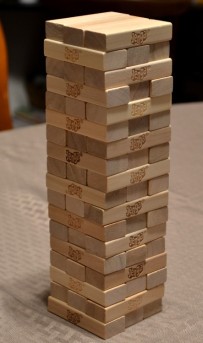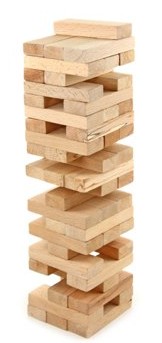Difference between revisions of "Project4W16"
(→Jenga Game (70 Points)) |
(→Jenga Game (70 Points)) |
||
| Line 65: | Line 65: | ||
* You have to use objects with physical properties to remove the blocks - for example you might attach a rigid stick to the controller, with which the user can push a block out of the stack. | * You have to use objects with physical properties to remove the blocks - for example you might attach a rigid stick to the controller, with which the user can push a block out of the stack. | ||
* You are allowed to use only one button on each controller of the Hydra, or one button of the zSpace stylus. | * You are allowed to use only one button on each controller of the Hydra, or one button of the zSpace stylus. | ||
| − | * | + | * If you use the Hydra, you need to implement a way for the player to move the camera, so that the player can see and reach all blocks in the tower from either side. |
| − | + | ||
==Extra Credit (10 Points Maximum)== | ==Extra Credit (10 Points Maximum)== | ||
Revision as of 08:45, 13 February 2016
Contents |
Jenga
This project is designed for use with either the Razer Hydra or the zSpace.
The Immersive Visualization Laboratory at the Qualcomm Institute has three Windows PCs with zSpaces available for the project. They will need to be shared between the groups that use them.
There will be a homework discussion on Wednesday Feb 17 at 1pm in WLH 220. Note that this time slot has moved from Monday due to the holiday.
Jenga is a popular game in which players take turns removing one block at a time from a tower constructed of 54 blocks. Each block removed is then balanced on top of the tower, creating a progressively taller but less stable structure. The player who successfully removes and places the last block wins.

|

|
| Starting configuration | Mid-game configuration |
Devices
Razer Hydra
To use the Hydra in Windows, you will need to first download and install the driver.
There is even an open-source Linux driver for the Hydra.
The Hydra SDK can be downloaded through Steam, but it's much easier to download it by its direct URL, which depends on your OS:
Getting the Hydra to work on a Mac seems a bit hacky. We hope you'll manage to do it anyways. The course staff will try to help you.
If you use Unity you will need the Unity plugin for the Hydra. For instructions on how to get the Unity plugin to work look here.
zSpace
The zSpace drivers and the SDK are already installed on the zSpace developer workstations, along with Visual Studio and Unity. We also already installed this Unity plugin on the zSpace PCs.
Menu System (30 Points)
TBA
Jenga Game (70 Points)
Based on information in a research paper from Carnegie Mellon University the Jenga blocks are (on average) 8.1cm long, 2.6 cm wide, and 1.8 cm tall, and they weigh 19.6 grams. The static friction coefficient they give is μ=0.4. You will need to implement a Jenga block with these parameters, including its physical properties.
You need to texture the bricks with a wood texture of your choosing, to make them look realistic.
Then you will need to build the tower in its initial configuration (see picture above). Note that you should introduce tiny amounts of randomness for each block's placement, to make the game playable and fun.
For this homework project, we simplify the game a little bit, in that we don't require that the player put the blocks back on top of the tower.
At the heart of the game are the players' turns in which they have to remove one block at a time. You don't need to distinguish between multiple players - just allow the user to remove a block at a time. How exactly you do the user interaction is up to you.
You will get points for the following things:
- Initial tower construction.
- Application of physics parameters and fine tuning.
- Textures on the blocks.
- You have to use objects with physical properties to remove the blocks - for example you might attach a rigid stick to the controller, with which the user can push a block out of the stack.
- You are allowed to use only one button on each controller of the Hydra, or one button of the zSpace stylus.
- If you use the Hydra, you need to implement a way for the player to move the camera, so that the player can see and reach all blocks in the tower from either side.
Extra Credit (10 Points Maximum)
You can obtain up to 10 additional points if you do one or more of the following things:
- Once a block has been removed, you require the player to put it on top of the tower (5 points).
- Jenga gun, like in this video. (5 points)
- You come up with a way to visualize the force the player is pulling with (for instance, a spring loaded stick to push, or you attach a spring to a block to pull on it) (10 points).
- You offer the player visual aids to know which blocks are looser, which you can do by visualizing the static forces in the entire stack. OpenSees might work for this but we haven't tried (10 points).
- If you have other ideas, ask us!